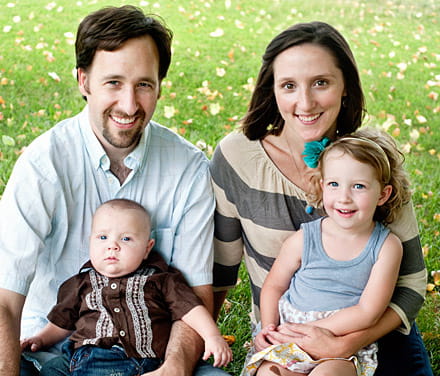Fetoscopic Surgery Repairs William’s Bladder Outlet Obstruction

Ask Loren Wolff what she thinks about the Cincinnati Children's Fetal Care Center and she’s quick to answer. “I really think the team is just amazing. I feel so lucky that we had them and their guidance,” she says.
That gratefulness is not only for the care she and her baby received from the team members. It is also for their open, honest approach that Loren emphasizes is both considerate and straightforward. “We had a difficult decision to make and we had no pressure from the Cincinnati Children's Fetal Care Center that one choice was better than the other,” recalls Loren, who lives in nearby Covington, Ky.
The Wolffs’ journey to the Cincinnati Children's Fetal Care Center began when Loren was 12 weeks pregnant and went in for a routine prenatal checkup. She measured bigger than she should have and an ultrasound showed an abnormally large bladder in her unborn son, William. He was diagnosed with bladder outlet obstruction, a condition in which the baby’s urethra is blocked and cannot adequately empty urine from the bladder.
The blockage can lead to the bladder becoming backed up and enlarged, which can cause kidney damage. It can also result in low amniotic fluid levels, which can threaten normal lung development. In some cases, fetal bladder outlet obstruction will correct itself. But William’s didn’t.
Kidney Damage Likely
The next several weeks were filled with frequent ultrasounds to monitor William’s condition. When Loren was 19 weeks along, she had an amniocentesis and her doctor determined that there was a danger to William’s kidneys. For an infant, lack of kidney function can be fatal. Loren and her husband, Ben, were referred to the Cincinnati Children's Fetal Care Center, where Loren was evaluated to determine if she would be a candidate for fetal surgery to repair the obstruction.
“The Cincinnati Children's Fetal Care Center really prepared us,” Loren says. “They walked us through what they call ‘decision points,’ so we knew every step of the way what might happen. With everything that’s unfolded with William, even the unexpected, we were well prepared.”
Loren was evaluated by Cincinnati Children's Fetal Care Center physicians Foong-Yen Lim, MD, William Polzin, MD, and Mounira Habli, MD. Nurses, social workers and genetic counselors were also part of the care team. And the center’s partnership with Cincinnati Children’s meant that the Wolffs also met with William’s future nephrologist and urologist.
A Quick, but Informed, Decision
If the Wolffs chose to have the surgery, it would need to be performed within the next week. The goal was for the surgery to halt further damage to the kidneys. That would give William a chance to survive with some kidney function until he was big enough to undergo a kidney transplant.
Loren and Ben weighed the risks and outcomes and decided that Loren would have the surgery. It was scheduled for Nov. 2, 2011.
In this procedure — called vesicoamniotic fetal shunting — Loren’s care team used a minimally invasive camera and instruments to access her uterus. They placed stents into William’s urethra to permit his urine to drain as it should. This would then protect the kidneys from increased pressure and would ensure enough amniotic fluid was present for his lungs to develop.
Hope for the Best
The surgery went well. Now the hope was for the stents to remain in place. Loren also had a port inserted by her ribs where she would get infusions of simulated amniotic fluids as needed to help continue developing William’s lungs. The Cincinnati Children's Fetal Care Center checked those fluid levels regularly as they monitored Loren’s progress throughout the remainder of her pregnancy.
The stents stayed in placed, and at 37 weeks on Feb. 6, 2012, it was time for the Wolffs to welcome William into their family. Loren was induced and delivered at Good Samaritan Hospital, another of the Cincinnati Children's Fetal Care Center partnering hospitals. As planned ahead of time, the Cincinnati Children’s Transport Team was ready and waiting, and William was taken to the Newborn Intensive Care Unit (NICU) right away, where he would spend the first three months of his life.
While in the NICU, the doctors determined that William’s kidneys had sustained considerable damage, which is irreversible. That means he had to go on immediate peritoneal dialysis, which removes waste products from the blood when the kidneys are unable to do the job. “It was agonizing for the first several months trying to figure out the balance between drugs and dialysis,” Loren says. He’ll continue dialysis until he’s big enough to have a kidney transplant — when he’s about 22 pounds — typically between age 1 and 2.
But there was some good news too. The surgery had done what it needed to for William’s lung development. “His lungs are fine now,” Loren says. All of this, Loren emphasizes, she and Ben were prepared for before William was even born, thanks to the caring guidance they received from the Cincinnati Children's Fetal Care Center.
William was finally discharged on May 4, 2012, and went home to meet his big sister, Leigh, age 3. “She’s handling it great,” Loren says. “One thing about us being prepared was that we could prepare her too.”
An Extended Family
William is now 5 months old and, according to his mom, “is a happy, easygoing baby.” He has monthly clinic visits with the Division of Nephrology and Hypertension to monitor his kidneys. He also has lab tests done monthly, which will continue until his transplant to make sure his medications are adjusted properly. “Nephrology has an amazing set of doctors and nurses,” says Loren. “They’re going to be in our family now.”
Looking back on the experience, Loren especially appreciates something Dr. Polzin said to her and Ben early on. “He said there’s no right answer — you just have to make a choice and not look back,” Loren says. “It was the best advice we got.”




